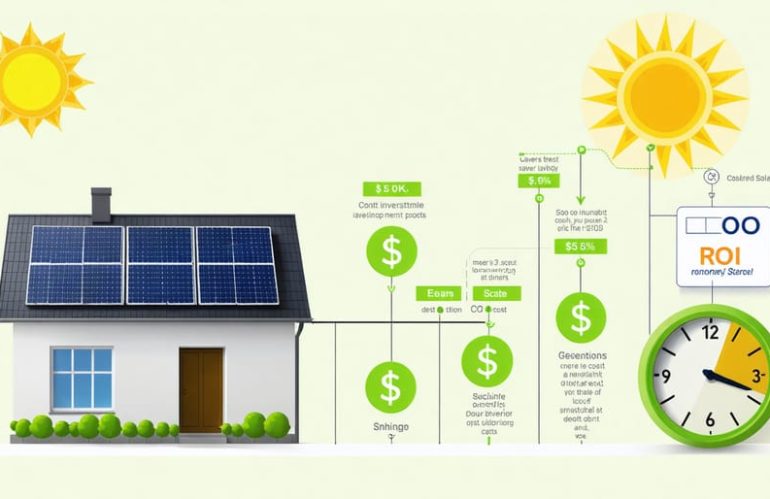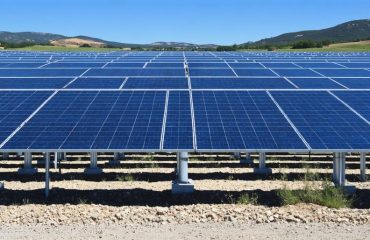Calculating solar panel ROI empowers homeowners to make informed decisions about their energy future and maximize their investment potential. Beyond the environmental benefits, understanding your solar investment’s financial return helps you navigate incentives, tax breaks, and long-term savings with confidence. Through a straightforward calculation combining upfront costs, energy savings, and available incentives, you can determine exactly how quickly your solar investment will pay for itself – typically between 5-10 years in most U.S. regions. Whether you’re considering a full home solar system or starting with a smaller installation, knowing your potential ROI is the crucial first step toward energy independence and reduced utility bills.
The key components of solar ROI include:
– Initial installation costs and available tax credits
– Current electricity rates and projected increases
– Average daily sun exposure in your location
– System performance and maintenance requirements
– Local utility incentives and net metering policies
This comprehensive guide walks you through each factor affecting your solar investment’s return, helping you make a data-driven decision about powering your home with solar energy.
Essential Cost Factors for Solar ROI
Initial Installation Costs
Understanding the initial installation costs is crucial for calculating your solar panel ROI. These upfront expenses typically range from $15,000 to $25,000 for an average residential system, though costs vary by location and system size.
The largest portion of your investment goes toward equipment costs, including solar panels ($5,000-$10,000), inverters ($1,000-$2,500), mounting hardware ($500-$1,000), and batteries if you opt for energy storage ($5,000-$7,000). Labor costs generally account for 25-35% of the total project expense, covering professional installation, electrical work, and system configuration.
Don’t forget to factor in permit fees ($250-$500), inspection costs ($200-$400), and any necessary electrical upgrades to your home ($800-$2,000). While these numbers might seem daunting, remember that federal tax incentives can offset up to 30% of your total system cost, and many states offer additional rebates and incentives to further reduce your out-of-pocket expenses.
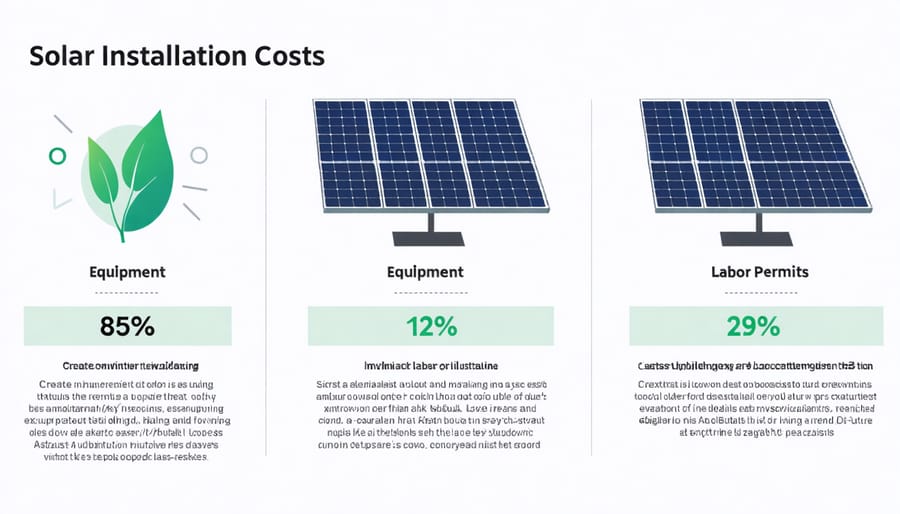
Available Tax Incentives and Rebates
One of the most significant factors in improving your solar panel ROI is taking advantage of available tax incentives and rebates. The federal solar tax credit, also known as the Investment Tax Credit (ITC), allows you to deduct 30% of your solar installation costs from your federal taxes through 2032. This substantial reduction in upfront costs can significantly accelerate your payback period.
Many states offer additional incentives, including tax credits, rebates, and performance-based incentives. For example, some states provide property tax exemptions for the added home value from solar installations, while others offer cash rebates based on system size. Local utilities may also provide incentives through net metering programs, allowing you to earn credits for excess energy production.
Remember to research specific programs in your area, as incentives vary by location and can change over time. Working with a qualified solar installer can help ensure you maximize all available financial benefits and properly factor them into your ROI calculations.
Energy Savings Potential
To estimate your potential energy savings, start by reviewing your past 12 months of electricity bills. Calculate your average monthly consumption in kilowatt-hours (kWh) and multiply it by your current electricity rate. Next, determine your solar system’s expected energy production based on your location’s sun exposure and panel efficiency.
Most solar installations can offset 70-90% of your current electricity usage. For example, if your monthly bill is $200, you could save $140-$180 per month, or $1,680-$2,160 annually. Keep in mind that savings vary by season, with higher production during summer months and lower during winter.
Remember to factor in annual electricity rate increases, which historically average 2-3% per year. This means your savings will likely grow over time as utility rates continue to rise, making your initial investment even more valuable.
Step-by-Step ROI Calculation Method
Determining Net System Cost
To find your net system cost, start with the total installation price and subtract all available incentives, rebates, and tax credits. The federal solar tax credit currently offers 30% off your total system cost, which can result in significant savings. Many states provide additional tax incentives and rebates, while some utility companies offer cash rebates or performance-based incentives.
For example, if your solar system costs $20,000, the federal tax credit would reduce it by $6,000. State incentives might offer another $2,000, and local utility rebates could provide $1,000, bringing your net cost down to $11,000. Don’t forget to factor in any solar renewable energy certificates (SRECs) you might be eligible for, as these can further reduce your overall investment.
Remember to research all available incentives in your area, as they can vary significantly by location. Some regions offer property tax exemptions for solar installations or low-interest solar loans, which can make your investment even more affordable. Keep in mind that while some incentives are immediate, others might be claimed when filing taxes or received over time.
Estimating Annual Benefits
To calculate your annual solar benefits, start by reviewing your past 12 months of electricity bills. Multiply your average monthly energy consumption in kilowatt-hours (kWh) by your current electricity rate to determine your baseline annual electricity costs. Your solar system’s expected energy production, typically provided by your installer, will help you estimate how much you’ll save on utility bills.
But energy savings are just the beginning. Factor in federal tax credits, which currently offer 30% of your total solar installation costs back as a tax credit. Many states and local utilities provide additional incentives, such as Solar Renewable Energy Credits (SRECs), performance-based incentives, or cash rebates. These can significantly boost your annual benefits.
Don’t forget to consider net metering benefits, where you can sell excess electricity back to the grid. This can add substantial value to your annual returns, especially during peak production months. Some utilities also offer time-of-use rates, which can increase your savings when solar production aligns with peak rate periods.
Property value increase is another important benefit. Studies show homes with solar installations typically sell for 4% more than comparable properties without solar. While this isn’t an annual cash benefit, it adds to your overall return on investment.
Remember to account for any maintenance costs, which are typically minimal for solar panels, averaging around $150-$300 per year for routine cleaning and inspections. These costs should be subtracted from your annual benefits to get a more accurate picture of your returns.
Final ROI Formula Application
To determine your solar panel investment’s complete financial picture, follow these straightforward steps for calculating your final ROI:
1. Calculate your total upfront costs (including installation and equipment)
2. Subtract any tax incentives, rebates, and local subsidies
3. Determine your annual energy savings
4. Add potential income from solar renewable energy credits (SRECs)
Your payback period is calculated by dividing your net investment (after incentives) by your annual benefits (energy savings plus SREC income). For example, if your net investment is $15,000 and you save $1,500 annually, your payback period would be 10 years.
For long-term returns, multiply your annual benefits by your system’s expected lifespan (typically 25-30 years) and subtract your initial investment. Remember to factor in:
– Average annual energy cost increases (historically 2-3%)
– Panel efficiency decrease (0.5-1% annually)
– Basic maintenance costs
Most homeowners see payback periods between 5-10 years and total ROIs of 200-400% over the system’s lifetime. Keep in mind that these figures can vary significantly based on your location, energy usage, and local incentives.
To maximize your ROI, consider timing your installation during off-peak seasons and thoroughly comparing quotes from multiple installers. Regular maintenance and monitoring will help ensure optimal performance throughout your system’s lifespan.
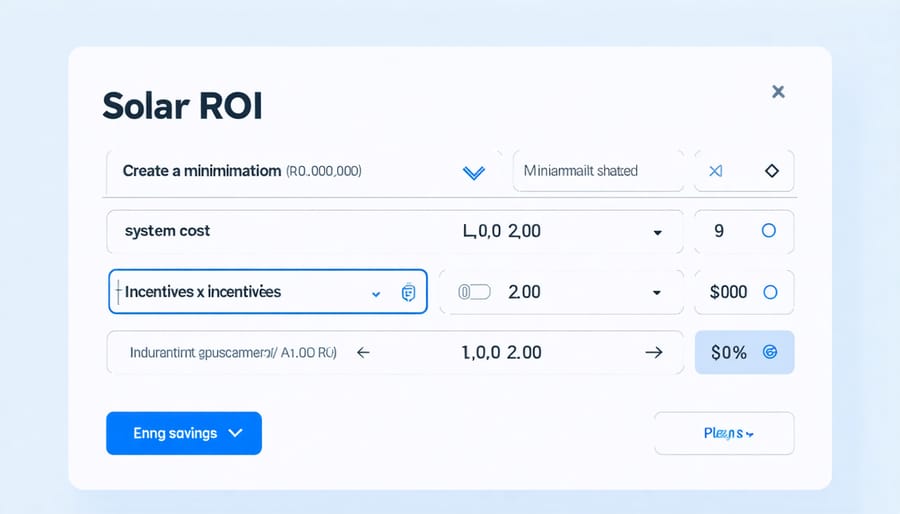
Maximizing Your Solar Investment
System Size Optimization
When it comes to maximizing your solar investment returns, determining the optimal system size is crucial. The goal is to strike a balance between your energy needs and available roof space while considering your budget and local utility policies.
Start by analyzing your annual electricity consumption from past utility bills. A well-sized system typically aims to offset 80-100% of your yearly energy usage. However, some factors might influence this target, such as net metering policies in your area or future changes in electricity consumption patterns.
Consider these key factors when sizing your system:
– Current electricity usage patterns
– Available roof space and orientation
– Local climate and sun exposure
– Future energy needs (electric vehicles, home additions)
– Utility company restrictions
– Budget constraints
Oversizing your system can lead to diminishing returns, especially if your utility doesn’t offer favorable net metering rates. Conversely, an undersized system might not provide the energy independence you’re seeking. Many homeowners find that a system sized to cover 90% of their current usage offers the best balance of cost and benefits.
Work with a qualified solar installer to analyze these factors and determine the most cost-effective system size for your specific situation. They can provide detailed production estimates and ROI calculations based on your local conditions and available incentives.
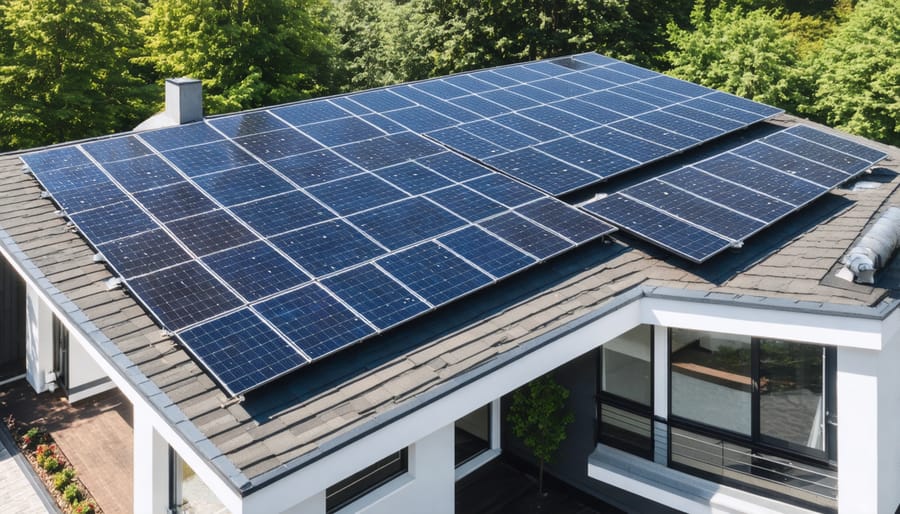
Maintenance Considerations
Solar panels are remarkably low-maintenance, which positively impacts your long-term ROI. Most systems require minimal upkeep, typically just periodic cleaning and occasional inspections. A well-maintained solar system can maintain over 90% of its original efficiency even after 25 years of operation.
The main maintenance tasks include cleaning dust and debris from panels 2-4 times per year, which you can often do yourself with a garden hose or soft brush. Professional cleaning services cost around $150-$300 annually but can increase energy production by 5-10%, making it a worthwhile investment for your ROI calculations.
Annual professional inspections, costing approximately $150-$200, help identify and address potential issues before they affect system performance. These inspections typically include checking electrical connections, mounting hardware, and monitoring system performance.
Most quality solar panels come with 25-year warranties, covering both equipment and performance. Inverters typically have shorter warranties of 10-12 years, so factor in one inverter replacement during your system’s lifetime when calculating ROI. This replacement usually costs between $1,000-$2,000.
Consider setting aside about $200-$300 annually for maintenance costs in your ROI calculations. While this might seem like an extra expense, proper maintenance ensures optimal system performance and helps you achieve maximum returns on your solar investment.
Future-Proofing Your Investment
When considering long-term solar investment benefits, it’s essential to factor in how future changes might affect your ROI. Solar panel technology continues to improve, with efficiency rates climbing steadily each year. While this might make some homeowners hesitant about investing now, today’s panels are already highly efficient and come with warranties typically lasting 25-30 years.
Energy prices have historically shown an upward trend, with average electricity rates increasing by 2-3% annually. This means your solar savings are likely to grow over time as utility costs rise, potentially improving your ROI beyond initial calculations. Additionally, many states are strengthening their renewable energy commitments, which could lead to more favorable incentives and policies for solar owners.
The durability of modern solar systems also plays a crucial role in future-proofing your investment. Most quality panels maintain over 80% of their production capacity even after 25 years, ensuring consistent energy generation for decades. Smart monitoring systems now allow you to track performance and optimize energy usage, helping maintain strong returns throughout the system’s lifetime.
Consider also that as battery storage technology becomes more affordable and efficient, you’ll have opportunities to upgrade your system and potentially increase your savings without replacing the entire installation. This scalability adds another layer of security to your solar investment.
Calculating your solar panel ROI doesn’t have to be complicated, and understanding the financial benefits can help you make an informed decision about your renewable energy investment. By following the steps outlined in this guide, you can accurately assess the potential returns from your solar installation while considering all the crucial factors that influence your bottom line.
Remember that while upfront costs may seem substantial, the long-term savings from reduced energy bills, tax incentives, and potential income from solar renewable energy credits can make solar panels a smart financial decision. The typical payback period of 5-10 years means you’ll enjoy free electricity for many years afterward, as most solar systems last 25-30 years.
To maximize your ROI, be sure to get multiple quotes from reputable installers, thoroughly research available incentives in your area, and consider factors like your roof’s condition and orientation. Don’t forget to account for potential increases in electricity rates, which can make your solar investment even more valuable over time.
Take action now by starting with a solar assessment of your property and gathering your recent energy bills. The sooner you begin your solar journey, the sooner you’ll start saving on energy costs while contributing to a more sustainable future. With solar panel prices continuing to decrease and energy costs rising, there’s never been a better time to invest in solar energy for your home.

